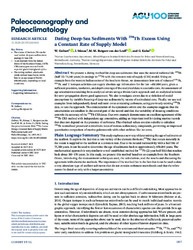Dating Deep-Sea Sediments With 230Th Excess Using a Constant Rate of Supply Model
DOI: https://doi.org/10.1029/2019PA003663
Persistent URL: http://resolver.sub.uni-goettingen.de/purl?gldocs-11858/9336
Persistent URL: http://resolver.sub.uni-goettingen.de/purl?gldocs-11858/9336
Geibert, W.; Stimac, I.; Rutgers van der Loeff, M. M.; Kuhn, G., 2019: Dating Deep-Sea Sediments With 230Th Excess Using a Constant Rate of Supply Model. In: Paleoceanography and Paleoclimatology, Band 34, 12: 1895 - 1912, DOI: 10.1029/2019PA003663.
 |
Dokument öffnen: |
We present a dating method for deep-sea sediments that uses the natural radionuclide 230Th (half-life 75,380 years) in analogy to 210Pb with the constant rate of supply (CRS) model. Using an example from the western Indian sector of the Southern Ocean, we demonstrate how sets of values of 230Th, 232Th, and U isotopes activities can supply absolute age information for the last ~450,000 years, given a sufficient precision, resolution, and depth coverage of the analytical data in a suitable core. An assessment of age uncertainties resulting from analytical errors using a Monte Carlo approach and an analytical solution for error propagation shows good agreement. We also investigate errors due to a violation of model assumptions by variable focusing of deep-sea sediments by means of a simulated core. Finally, we use real examples from independently dated sediment cores containing carbonate, using previously existing 230Th data, to test the approach. The consideration of the systematic errors and the examples suggests that the uncertainties are smallest in the central part of the record and that the variability of focusing conditions controls the accuracy of the 230Th CRS dates. Our own example demonstrates an excellent agreement of the 230Th CRS method with independent age constraints, adding an important tool for dating marine records that does not depend on the presence of carbonate. The obtained values are also suitable to calculate 230Th-normalized preserved vertical rain rates of various sedimentary compounds, permitting an improved quantitative comparison of marine paleorecords with other archives like ice cores.
Statistik:
ZugriffsstatistikSammlung:
This is an open access article under the terms of the Creative Commons Attribution-NonCommercial License, which permits use, distribution and reproduction in any medium, provided the original work is properly cited and is not used for commercial purposes.

